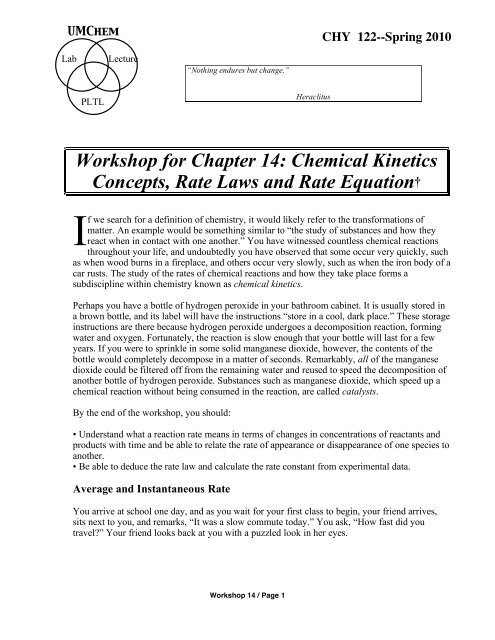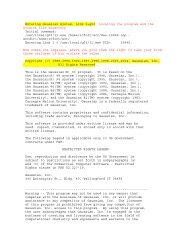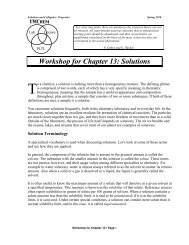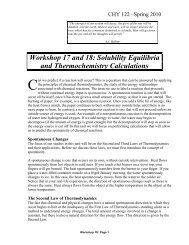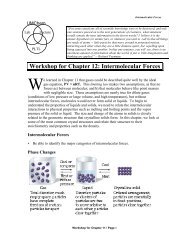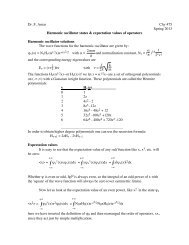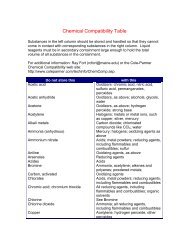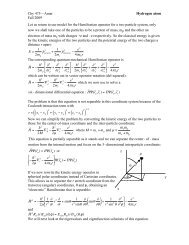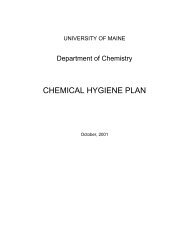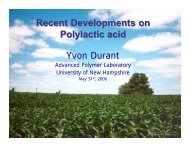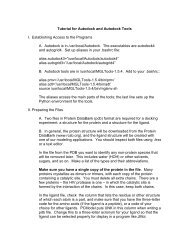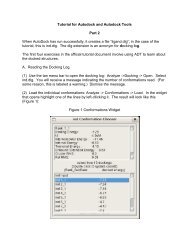Workshop for Chapter 14: Chemical Kinetics Concepts, Rate Laws ...
Workshop for Chapter 14: Chemical Kinetics Concepts, Rate Laws ...
Workshop for Chapter 14: Chemical Kinetics Concepts, Rate Laws ...
Create successful ePaper yourself
Turn your PDF publications into a flip-book with our unique Google optimized e-Paper software.
UMChemCHY 122--Spring 2010LabLecture“Nothing endures but change.”PLTLHeraclitus<strong>Workshop</strong> <strong>for</strong> <strong>Chapter</strong> <strong>14</strong>: <strong>Chemical</strong> <strong>Kinetics</strong><strong>Concepts</strong>, <strong>Rate</strong> <strong>Laws</strong> and <strong>Rate</strong> Equation†If we search <strong>for</strong> a definition of chemistry, it would likely refer to the trans<strong>for</strong>mations ofmatter. An example would be something similar to “the study of substances and how theyreact when in contact with one another.” You have witnessed countless chemical reactionsthroughout your life, and undoubtedly you have observed that some occur very quickly, suchas when wood burns in a fireplace, and others occur very slowly, such as when the iron body of acar rusts. The study of the rates of chemical reactions and how they take place <strong>for</strong>ms asubdiscipline within chemistry known as chemical kinetics.Perhaps you have a bottle of hydrogen peroxide in your bathroom cabinet. It is usually stored ina brown bottle, and its label will have the instructions “store in a cool, dark place.” These storageinstructions are there because hydrogen peroxide undergoes a decomposition reaction, <strong>for</strong>mingwater and oxygen. Fortunately, the reaction is slow enough that your bottle will last <strong>for</strong> a fewyears. If you were to sprinkle in some solid manganese dioxide, however, the contents of thebottle would completely decompose in a matter of seconds. Remarkably, all of the manganesedioxide could be filtered off from the remaining water and reused to speed the decomposition ofanother bottle of hydrogen peroxide. Substances such as manganese dioxide, which speed up achemical reaction without being consumed in the reaction, are called catalysts.By the end of the workshop, you should:• Understand what a reaction rate means in terms of changes in concentrations of reactants andproducts with time and be able to relate the rate of appearance or disappearance of one species toanother.• Be able to deduce the rate law and calculate the rate constant from experimental data.Average and Instantaneous <strong>Rate</strong>You arrive at school one day, and as you wait <strong>for</strong> your first class to begin, your friend arrives,sits next to you, and remarks, “It was a slow commute today.” You ask, “How fast did youtravel?” Your friend looks back at you with a puzzled look in her eyes.<strong>Workshop</strong> <strong>14</strong> / Page 1
<strong>Chapter</strong> <strong>14</strong>How do you respond to someone who asks about the speed of a trip? If the distance from hometo school is ten miles and it takes a half hour to make the trip, your average speed, or averagerate of travel, is 20 miles per hour. However, along the way you may have gone as fast as 45mph, but at other times you were stopped. Your speed at any given instant, your instantaneousrate, is shown by your speedometer reading at that moment. Clearly, there are two ways ofexpressing rates, your choice of which depends on the type of in<strong>for</strong>mation that is needed.The rate of a chemical reaction is defined as the change in concentration of a reactant or productof that reaction per unit time. This can be expressed as ∆[A]∆t. Just as with the speed of a tripfrom home to school, chemical reaction rates can be average or instantaneous. To obtain aninstantaneous rate, the reaction needs to be examined over a time period small enough to ensurethat the reaction has proceeded only slightly.Instantaneous rates are determined experimentally by the application of a technique known as themethod of initial rates. The initial instantaneous rate of reaction is approximated by measuringthe change in concentration in the smallest time interval practical.∆[A]∆t≅[A] t = 1 – [A] t = 0t 1 – t 0(<strong>14</strong>.1)This provides a good approximation to the instantaneous rate = ± ∆[A]∆tdepending on whetherA is product (+) or reactant (-). We can measure the initial rate <strong>for</strong> different initial concentrationsof each of the reactants, and from those data, find the rate order. The value of the rate constantfollows because now we know the initial rate, the initial concentrations, and the rate orders <strong>for</strong>each reactant.<strong>Rate</strong> <strong>Laws</strong>A rate law describes how the reaction speed depends on the concentrations of reactants andproducts. It is determined from experiments that measure the change in concentration of one ormore of the reactants or products over time. Consider the following rate laws that can apply tothe general reaction: A + B → Products:rate = – ∆[A]∆trate = – ∆[A]∆trate = – ∆[A]∆trate = – ∆[A]∆t= k [A] (<strong>14</strong>.2)= k [A] 2 (<strong>14</strong>.3)= k [A] [B] (<strong>14</strong>.4)= k (<strong>14</strong>.5)<strong>Workshop</strong> <strong>14</strong> / Page 2
<strong>Chemical</strong> <strong>Kinetics</strong>Equations <strong>14</strong>.2–<strong>14</strong>.5 express the rate of the reaction in terms of the disappearance of A,rate = - ∆[A]∆t. This rate is proportional to the molar concentration of A and/or B, raised to apower. In each case, the proportionality constant is given by k, which is known as the rateconstant.The term reaction order is used to refer to the exponents of the concentrations. We can refer tothe overall reaction order, the sum of the exponents of all of the reactants, or the reaction order ofa particular reactant, the exponent of that reactant. For example, the rate law in Equation <strong>14</strong>.3 issaid to be second order with respect to A. For Equation <strong>14</strong>.4, the reaction is second order overalland first order <strong>for</strong> each of the reactants.Important Note: the order of the reaction often does not simply reflect the reactionstoichiometry.The rate laws we have seen so far express the relationship between rate and concentration.Another <strong>for</strong>m <strong>for</strong> expressing rate laws is to show the relationship between concentration andtime. These are called integrated rate laws. The chart below shows the differential rate law, thetype we first introduced, and the corresponding integrated rate law <strong>for</strong> zeroth, first, and secondorder reactions. It also show how an appropriate X-Y plot yields a straight line if the data obeysone of these rate laws.Differential <strong>Rate</strong> Law Integrated <strong>Rate</strong> Law Plot of ... ... gives straight linewith sloperate = +k [A] = [A] 0 – kt [A] vs t -krate = +k [A] [A] = [A] 0 × e –kt ln([A]/[A] 0 vs t -krate = +k [A] 2 1[A]=1[A] 0The rate constant can be expressed in an alternate <strong>for</strong>m known as the half-life of the reaction,which is defined as the time needed <strong>for</strong> the reactant concentration to fall to exactly half of itsoriginal concentration. Half-lives are most commonly used <strong>for</strong> first-order reactions. Therelationship between the half-life and the rate constant <strong>for</strong> a first-order reaction is given by+ kt1[A]vs t+kt 1/2 = ln 2k(<strong>14</strong>.6)ReversibilityIt is often the case that the rate of reaction will depend not only on the reactant concentrationsbut also the product concentrations as well. For example, the experimentally-determined rate law<strong>for</strong> the reactionk 1A B (<strong>14</strong>.7)<strong>Workshop</strong> <strong>14</strong> / Page 3
<strong>Chapter</strong> <strong>14</strong>may bek –1[ ]rate = " # Adt[ ]= # Bdt= k 1 [ A]" k "1 [ B] (<strong>14</strong>.8)In this case, the reaction is said to be reversible. You will see that kinetic reversibility is closelyconnected with the concept of equilibrium.!Elementary ReactionsElementary reactions or elementary steps are reactions that represent the actualcollision of reactant molecules and rearrangement into product molecules. The rate law<strong>for</strong> an elementary reaction can be deduced directly from the stoichiometry of the reaction.For example,n A + m B products (<strong>14</strong>.9)has the rate law:rate = k[A] n [B] m (<strong>14</strong>.10)If two molecules collide in an elementary reaction we say the reaction is bimolecular (itsmolecularity is 2) and the rate law <strong>for</strong> this elementary step is second-order overall.Termolecular reactions in the gas phase are rare because they require 3 molecules tocollide simultaneously in one small region of space!Mechanisms of <strong>Chemical</strong> ReactionsA mechanism <strong>for</strong> a chemical reaction is set of elementary reactions which satisfytwo conditions:1) the sum of the elementary reactions must give the overall reaction exactly; and2) The overall rate law derived from these elementary steps is consistent with theobserved rate law <strong>for</strong> the overall reaction.The slowest elementary reaction in a mechanism is called the rate-determining step. Inkinetics experiments in general, no matter the reaction type, chemists typically begin bymeasuring and determining rate orders, and then they try to devise mechanisms that areconsistent with the rate orders observed experimentally. Un<strong>for</strong>tunately, neither themolecularity nor the rate order is necessarily given by the overall stoichiometry <strong>for</strong> areaction.Consider the reaction:H 2 (g) + 2 ICl (g) 2HCl (g) + I 2 (<strong>14</strong>.11)which is found experimentally to be first-order in H 2 and first order in ICl. If the reactionas written were an elementary reaction, it would have to be termolecular and would befirst order in H 2 and second order in ICl. There<strong>for</strong>e the reaction is NOT elementary. Thefollowing two-step mechanism is consistent with the experimental data:Step 1: H 2 (g) + ICl (g) HI (g) + HCl (g) (slow)Step 2: HI (g) + ICl (g) → HCl (g) + I 2 (g) (fast) (<strong>14</strong>.12)<strong>Workshop</strong> <strong>14</strong> / Page 4
<strong>Chapter</strong> <strong>14</strong>Self Test1. a) Consider the combustion of ethylene, C 2 H 4 (g) + 3 O 2 (g) 2 CO 2 (g) + 2 H 2 O(g). Ifthe concentration of C 2 H 4 is decreasing at the rate of 0.18 M/s, what are the rates ofchange in the concentrations of CO 2 and H 2 O? b) The rate of decrease in N 2 H 4 partialpressure in a closed reaction vessel from the reaction N 2 H 4 (g) + H 2 (g) 2 NH 3 (g) is 60torr/hr. What are the rates of change of NH 3 partial pressure and total pressure in thevessel?2. For each of the following rate expressions, state the order of reaction with respect to A,the order of the reaction with respect to B. and the overall order of the reaction.a) rate = k [A] [B]b) rate = k [A] [B] 2c) rate = kd) rate = k [A] [B] 1/23. The first-order rate constant <strong>for</strong> the radioactive decay of radium-223 is 0.0606day -1 . What is the half-life of radium-223?4. What is the molecularity of each of the following elementary processes? Writethe rate law <strong>for</strong> each.a) CH 2 (g) + Cl 2 (g) CH 2 Cl 2 (g)b) SO 3 (g) SO 2 (g) + O(g)H 2Cc)CH 2CH 2(g) CH2 =CH-CH 3 (g)<strong>Workshop</strong> <strong>14</strong> / Page 6
<strong>Chemical</strong> <strong>Kinetics</strong><strong>Workshop</strong> <strong>14</strong>: <strong>Chemical</strong> <strong>Kinetics</strong> <strong>Concepts</strong>, <strong>Rate</strong> <strong>Laws</strong>,and <strong>Rate</strong> Equations1. Modeling the <strong>Rate</strong> of a ReactionThe rate of a reaction measures how fast a reaction proceeds. For a simple reaction,reactant “A” reacts to <strong>for</strong>m a product, “B”.A BLet’s model a reaction in which 10 % of the concentration of A reacts per second. Ateach second, 10 % of the concentration of A reacts to <strong>for</strong>m the product B. Start with 100pieces of candy, which represents a concentration of 100 mM (millimolar). At eachsecond, transfer 10 % of the candies from one container to the other. Repeat the process15 times, representing 15 seconds. Always transfer whole pieces of candy, roundfractions to the nearest whole piece of candy (0.5 round up to 1). Record your resultsbelow.Time (s) [A] (mM) [B] (mM) Ln [A]0 100 0 4.6112345678910111213<strong>14</strong>15Plot the concentration of A versus time on the graph below. Use a different color to plotthe concentration of B versus time on the same graph.<strong>Workshop</strong> <strong>14</strong> / Page 7
<strong>Chapter</strong> <strong>14</strong>Concentration vs. Time <strong>for</strong> A B100Conccentration (mM)50005Time (s)10 15Based on the graph, calculate the instantaneous rate at 2 s, 5 s, and 10 s <strong>for</strong> [A]. Is thisrate changing? Compare these rates to the instantaneous rates at 2 s, 5 s, and 10 s <strong>for</strong> [B].How do they compare.Based on the graph, what is the average rate of the reaction?Part II: First order reactionsNow calculate ln (A], and record the data in the table. Plot ln [A] versus time on thegraph below.ln [A] vs. Time <strong>for</strong> A B5ln [A]430Time (s)510 15Determine the slope of the best-fit straight line <strong>for</strong> the plot of ln [A] vs. time. How doesthis slope relate to the fact that 10 % of A reacted per second?<strong>Workshop</strong> <strong>14</strong> / Page 8
<strong>Chemical</strong> <strong>Kinetics</strong>2. Initial rates <strong>for</strong> the reaction of nitrogen monoxide and chlorine2NO(g) + Cl 2 (g) → 2NOCl(g)were measured at 27 °C starting with various concentrations of NO and Cl 2 . These datawere collected.experiment Initial conc (mol/L) Initial conc (mol/L) Initial rate (mol L -1 s -1 )[NO][Cl 2 ]1 0.020 0.010 8.27 x 10 -52 0.020 0.020 1.65 x 10 -43 0.020 0.040 3.31 x 10 -44 0.040 0.020 6.60 x 10 -45 0.010 0.020 4.10 x 10 -5What is the rate law?What are the units of the rate constant k?What is the value of k?Calculate k <strong>for</strong> each of the five experiments. The value should be the same <strong>for</strong> eachexperiment.<strong>Workshop</strong> <strong>14</strong> / Page 9
<strong>Chapter</strong> <strong>14</strong>3. Examine the units <strong>for</strong> the following hypothetical rate constants. Based on the units, whatis the overall order of each reaction?a. k = 0.57 M s -1b. k = 6.31 x 10 -3 s -1c. k = 2.1 x 10 1 L mol -1 min -1d. k = 36.5 mol -2 L 2 s -<strong>14</strong>. If the initial concentration of the reactant in a first-order reaction A → products is0.64 mol/L and the half-life is 30. s,Calculate the concentration of the reactant 60 s after initiation of the reaction.How long would it take <strong>for</strong> the concentration of the reactant to drop to one-eighthits initial value?How long would it take <strong>for</strong> the concentration of the reactant to drop to 0.040 mol L -1 ?<strong>Workshop</strong> <strong>14</strong> / Page 10
<strong>Chemical</strong> <strong>Kinetics</strong>5. Consider the following rate expression, and then answer the following questions.Each person should answer one part in a round robin.The reactionobeys the following rate law:2 NO(g) + O 2 (g) → 2 NO 2 (g)rate = k [NO] 2 [O 2 ]In each case, decide if the given mechanism is consistent with the overall rate lawand discuss its merits.(a) Step 1: NO + O 2 NO 2 + O (slow)Step 2: NO + O NO 2(fast)(b) Step 1: NO + NO NO 2 + N (slow)Step 2: N + O 2 NO 2(fast)(c) Step 1: NO + NO + O 2 2 NO 2(d) Step 1: NO + O 2 ↔ NO 2 + O (fast equilibrium)Step 2: NO + O NO 2(slow)<strong>Workshop</strong> <strong>14</strong> / Page 11


